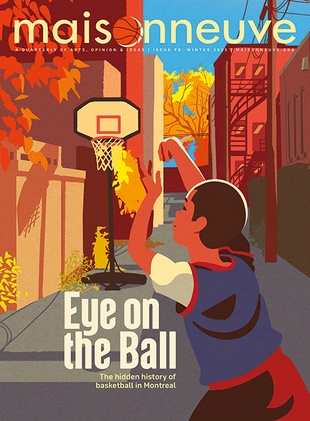 Photo courtesy of Unsplash: Karina Karina.
Photo courtesy of Unsplash: Karina Karina.
The Many Annes
There’s more than one way to read L. M. Montgomery’s literary heroine, from feminist trailblazer to conservative tradwife.
I am not sure when exactly Lucy Maud Montgomery’s Anne of Green Gables introduced me to the character of Anne Shirley. She was always just there, a ubiquitous part of my life as an Atlantic Canadian. I do remember visiting, at eight years old, what is now known as Green Gables Heritage Place in Prince Edward Island, the farm that served as the setting for the novels. It’s possible I knew Anne’s story before I posed for a photo in front of the Green Gables house, resplendent with brilliant white shingles and its iconic green trim—but, if not, I definitely knew it afterward. Life as I know it started the day of that snapshot. In the photo, I have my large, cuddly doll, Kelly, snugly zipped into my jacket with me. My thick black hair is cropped into a mullet. I remember exactly how the air felt, the combination of the stiff ocean breeze and the bright summer sun. I also remember the gift shop, where I got a box set of the first three books in Montgomery’s bestselling series.
What I don’t remember is being happy. That modest five-day family vacation, a precious treat that I now know must have required careful scrimping and saving, wasn’t overly child-friendly. I was the problem. I was a child, acting like a child. I yearned for vivid lilac-coloured blackberry ice cream in an overpriced novelty shop. I whined when I saw samples of free fudge. Worst of all, I longed to go to the beach. For reasons I still don’t understand, this was a problem for us in PEI, a province that is nothing but beach. I dutifully attended free tours of the provincial legislature and trailed behind my father as he examined antique farm equipment. I absorbed family tension, and I felt like a bother.
But when I read those books, I felt free. Anne, too, was an annoying, awkward girl. She blurted out odd things, never quite seemed to fit in at school or church, and could daydream by the hour. As Montgomery might phrase it, Anne and I were kindred spirits. We both poured over books, cared deeply about school and lamented our looks. Here was a little girl who also loved the sea, found it hard to hold her tongue and desperately wanted people to like her. I devoured all things Anne. I easily read and re-read the novels a hundred times. The second box set, containing books four to six of the eight-volume series, soon followed suit. In university, I turned again and again to the third installment, Anne of the Island, which follows Anne as she departs from Green Gables to study in Nova Scotia. Reading about her university days as I enjoyed my own deepened my sense of kinship. We were exactly alike, loving our studies and baking lemon pies for our friends. When I learned about the two additional books in the series, it felt like I had discovered lost demo tapes by my favourite rock star. As I read the pages, I let myself be absorbed by the world Montgomery had created. It’s a world I’ve long credited for my ambition, feminist beliefs and outlook on life: a sense of appreciation for small beauties and friendships, and of the value of working to know oneself better after every mistake. Anne’s world became my refuge.
Nurtured by her adoptive family, Matthew and Marilla Cuthbert, accepted for who she was by her best friend, Diana Barry, and nourished intellectually by teachers and mentors, Anne has it all. She becomes the first girl from her fictional community of Avonlea to go to university—with scholarships, thank you very much. Her deep friendships develop into rich adult relationships. And, of course, she eventually marries Gilbert Blythe, the most popular boy in school, a boy whose affections she rejected until she was ready for a relationship on her own terms. As Anne settles into married life and grows older, she is regarded as a kind, non-judgemental person who always offers comfort and heartfelt advice. Even the very premise of her story—that an elderly brother and sister in need of farm help decide to adopt a boy and are sent a girl instead—seemed designed to tell me that girls can become anything they want. In short, Anne was the very prototype of what I wanted to be: her own woman, a strident feminist and a flawless role model.
Lately, I’ve been wondering if I was wrong.
There’s a different lens through which you can examine Anne’s life, one that allows you to notice how she sews lace on her daughters’ dresses, never complains when her husband is away for work and always has a basket full of homemade baking ready to bring to the church fair. Anne’s pantry is spotless. She backs her husband’s political opinions. She cheerfully has babies almost every year. Everyone admires her slim figure, flawless taste and chic style. If you didn’t know I was writing about a fictional character from the turn of the century, you’d be forgiven for thinking I was describing a tradwife.
Yes, a tradwife: a contemporary subculture of women who embrace traditional marriage and gender roles, and reject outside employment in favour of household work, raising children and supporting their husbands. There’s an aesthetic to match, one that celebrates homemade cakes, dainty dresses and pretty flowers. This is more than a social media trend saturated with hand-knit sweaters, charming kitchens and painstakingly prepared homemade pasta. The darker side of this phenomenon is discussed by academics Sophia Sykes and Veronica Hopner, who write for the Global Network on Extremism and Technology research initiative that the subculture is designed to pair ideology with aesthetic: “Presenting a softer and more palatable voice for right-wing ideology through their construction of a #tradlife, tradwives use their presence on social media to offer a powerful female in-group association and supply often extremist solutions to perceived demands placed on both women and men in modern Western societies.”
Anne of Green Gables as a secret militant tradwife? She doesn’t exactly seem the type to celebrate guns or alt-right policies. Can you imagine Anne commodifying her lifestyle with a social media regime dedicated to broadcasting her homesteading, complete with affiliate links in a baking blog? Yet she does seem the type, in a way. Anne is a champion of marriage and a perpetual matchmaker. She steadfastly supports the war effort even though one of her sons is a pacifist. (In the last book set primarily in Anne’s universe, Rilla of Ingleside, Canada enters World War I.) And she doesn’t exactly defend people with unpopular opinions, like when a community member speaks out against the war, choosing instead to remark upon them with shock when she’s back in the safety of her home with her most ardent admirer, Susan the housekeeper. How did I miss this? What happened to the woman who blazed an academic trail, supported herself with freelance writing and turned down four marriage proposals?
The answer might lie partly with Anne’s creator. Montgomery, too, was both a feminist trailblazer and living in a very traditional marriage. She and Anne are similar in other ways. Like her most famous character, Montgomery had an early childhood filled with neglect, and found solace in the tranquil countryside of Prince Edward Island. She, too, trained to be a teacher and qualified to attend university, similarly earning her keep by freelancing. Like Anne, she found stability and respectability through marriage and status. Anne became a doctor’s wife, and Montgomery a minister’s. Tragedies that touched Montgomery’s life, including the loss of a baby, were also written into her work.
There are notable points at which their lives diverge. Unlike Anne, Montgomery kept writing after marriage, putting in several hours a day while completing all the social and administrative duties that come with being a minister’s wife. Unlike Anne, she was not partnered with the love of her life. Montgomery’s husband, the Reverend Ewen Macdonald, is said to have lacked intellectual curiosity and interest in literature. The contrast between him and Anne’s beloved Gilbert couldn’t be more stark. Gilbert is an early and enthusiastic champion of Anne’s writing and education. As newlyweds, it’s Gilbert who teasingly points out, during a conversation about how their friend Leslie should be living a life within esteemed social and intellectual circles, that perhaps Anne herself is missing out. After all, she’s a university graduate who had a promising writing career and became no more than the wife of a struggling country doctor. Anne responds that there’s nothing she wants more than to be his wife. One can’t help but wonder if Montgomery secretly wished her own husband would have acknowledged her talents, and worried if she was squandering them as a wife.
Montgomery didn’t write the Anne books in order. Book four, Anne of Windy Poplars, was released in 1936, while book six, Anne of Ingleside, was published in 1939—fifteen and eighteen years after the chronologically final installment, Rilla of Ingleside, debuted in 1921. Montgomery married in 1911, meaning Anne of Windy Poplars was published the year of her and her husband’s twenty-fifth anniversary. Re-reading the text, I’m struck by what seems to matter most to Anne, as well as what doesn’t. This epistolary-style novel tells the story of Anne and Gilbert’s long-distance engagement while she is a school principal and he a medical student. However, what stands out most in the book are the female relationships, including the bonds Anne forms with her housekeeper, an isolated neighbourhood girl and her female students. She says she misses Gilbert, but this is very much a portrait of a young woman in her prime: financially independent, highly educated, living a robust and meaningful life. Is this how Montgomery remembers her pre-marriage life? Was she trying to give Anne a final burst of freedom that she herself never had?
The Anne that Montgomery sketches three years later in Anne of Ingleside is a vastly different creature. Designed to showcase Anne and Gilbert’s lives as young parents, much of the text focuses on their children’s innocent misadventures. Anne’s life is largely portrayed with sickly sweetness, but in the second-last chapter, there’s a paragraph that breaks down the facade of the perfect wife and mother: “Everything annoyed her these days. A little mannerism of Gilbert’s she had never minded before got on her nerves. She was sick-and-tired of never-ending, monotonous duties ... sick-and-tired of catering to her family’s whims. Once everything she did for her house and household gave her delight. Now she did not seem to care what she did. She felt all the time like a creature in a nightmare, trying to overtake someone with fettered feet.”
These sound like the words of an author eager to lay bare the grim realities facing women—at least until the final chapter. Anne and Gilbert are reunited with his once-rumoured sweetheart and her old rival, Christine. Childfree and widowed, Christine says that she never thought it was a woman’s sole mission to bring children into an overcrowded world, and asks Anne, “Do you really never feel that you want a broader life? You used to be quite ambitious, if I remember right.” When Gilbert later reassures Anne that she remains the love of his life (and that he thinks Christine has gotten fat), Anne is smug and satisfied. The last lines Montgomery ever wrote in a story focused on Anne look down on Christine’s childlessness. What are we to do with all these contradictory versions of Anne? And what does this tell us about Montgomery, a prim and proper pastor’s wife and literary legend, albeit one who was never feted among the elite artists of her time? Who is the Christine in Montgomery’s life, challenging her choices—is it Montgomery, challenging herself?
I’m not the only one who has pondered the question of how we should think of Anne and Montgomery. Since its publication in 1908, the first book in the series, Anne of Green Gables, has sold more than fifty million copies. The series has inspired at least four films, seven radio productions, several stage productions, five animated television films and series and twelve non-animated television films and series, plus countless web productions, comics and parodies, fan fiction and fan art, and a vast world of official and unofficial merchandise. In each rendition, the story of Anne is seen in a slightly different light, from a gun-slinger (yes, really) to a queer Tennessee teen. In the 2017 CBC/Netflix series, Anne with an E, Anne lives in a world in which issues of race, class and sexuality are at the forefront, and trauma, bullying and reconciliation are common themes. In contrast, CBC’s 1985 four-part television mini-series is faithful to Montgomery’s first two books, with Anne’s imagination, capacity for friendship and bad luck getting into mischief taking centre stage.
Brenton Dickieson is a writer, researcher and the host of The MaudCast, the podcast of the L.M. Montgomery Institute at the University of Prince Edward Island. Interpreting the multitudes contained within Montgomery and her characters is what he does. “My argument is that Montgomery is creating fairy lands,” he says, pointing out that these are books for children, and that there is an inherent contrast between the real world that Montgomery and her readers live in and the fantastical land that she created. “What’s critical to Montgomery in all her novels is that we at least attempt to see things from a child’s point of view,” says Dickieson. “We have to change our angle of view in order to enjoy the books.” He points out that life gets complicated for Montgomery’s characters as they grow up, noting that in Anne’s House of Dreams, the fifth in the series, Anne starts to face real-world issues. “It’s a marvelous and a terribly difficult book … And I think that’s the key for Montgomery … Anne needed to learn self-sacrifice as Montgomery did herself,” says Dickieson. Self-sacrifice is something that Montgomery knew all too well, weaving many of her adult struggles into Anne’s life while trying to retain the spirit of the “fairy land” for her readers—much as Anne later does for her children, shielding them from domestic duties and encouraging play. Does Montgomery pull it off? It’s hard to say. “I don’t know that Anne survives fairy land as an adult,” says Dickieson. It makes me wonder what we lose when we look at an imaginative world designed for children through our adult eyes.
For a time, there was a risk that the popularity of Anne of Green Gables would remain as that of a well-loved series, with no deeper level of scholarship. Dickieson points out that the first scholarly work about Montgomery’s life didn’t really emerge until about twenty-five years after her death. Her legacy was rescued by feminist scholars who saw the value in examining Montgomery’s interiority, reviewing and eventually publishing her journals. The question of “feminist versus traditionalist” exists when we think about Montgomery and her characters because feminist scholars encouraged this level of reflection, recognizing that Anne’s world was so much more than a series of books. “What the feminist scholars saw, and what imaginative readers typically see, is the question we sometimes don’t ask: Is this a liberating force? Does it incarcerate the soul, or does it liberate the soul?” says Dickieson. “And they found … all these characters of Montgomery’s were [a liberating force] … there’s a whole kind of energy toward that freedom.”
I can now appreciate that for Anne, orphaned as an infant and passed from loveless house to loveless house as a workhorse before finding a nurturing family environment with the Cuthberts, a traditional life seems to serve the purpose of liberating her soul. She can have the life she wants as a scholar, friend, wife and mother. The theme of liberation runs subtly through Montgomery’s work, much like the gentle brook that traverses Anne and Gilbert’s first homestead. The character of Leslie, for whom traditional marriage roles are most decidedly not liberating, finds a new life without her abusive husband. Anne’s college mate Philippa, who chases a math scholarship just to spite an old professor who vehemently opposed admitting female students, is liberated from class and family pressures and marries a most unlikely match in Jonas, the homely minister. Marilla herself, Anne’s adoptive mother, is set free from a grey world when Anne brings it to life in technicolour glory. Little Anne is a chatterbox, asking questions about everything and challenging the doctrine which had dictated Marilla’s life, from praying at night to sewing patchwork. Anne dares to say out loud the thoughts that Marilla never dared acknowledge, like how a minister is boring or a neighbour is a gossip. Before Anne, Marilla had only looked upon fruit trees to calculate how much jam they might produce. After Anne, they become a source of dreamy blossoms, romantic fancies and enchanting smells.
Not all characters are so lucky. Diana, Anne’s best friend, proves herself time and time again to be brave, loyal, supportive and encouraging. She loves school and is a model of fairness, never grasping for credit or shirking blame. Nonetheless, her parents won’t permit her to join the college preparatory class. (There’s a happier path for her in Anne with an E, in which Diana does take the admission exams). Even Rilla, Anne and Gilbert’s youngest child, has an uncertain fate. Once a pampered teenager of whom not much is expected, she rises to the challenge of caring for a homeless infant, organizing a junior Red Cross committee and maintaining a semblance of normalcy for her parents while her older siblings are away during the war. A sea of possibilities is thwarted when the war ends, and a family friend returns to claim her hand. Like her mother, any avenue for ambition seems to have been cut short. But while Anne finds liberation through family and domesticity, will Rilla? The answer is unclear. Again and again, Montgomery seems to be telling us that a woman can be as happy, creative and unique as she likes—so long as she conforms. Montgomery’s women are happy mothers, even those who don’t birth children. Marilla finds liberation when she mothers Anne. Susan the housekeeper is a second mother to Anne’s children. Leslie, Diana and Philippa all eventually follow the path to motherhood.
Who is the real Anne? Is she the open-minded woman who has frank conversations with her friend Leslie, trapped in a loveless, impoverished marriage to a once-abusive man she must now nurse? Is she the student who sets up house with her girlfriends, creating a cozy nest filled with books, cats, cakes and joyful independence? Is Anne still that irrepressible, passionate, dreamy girl who embodies my ideas of autonomy and authenticity? Or is she someone whose personality is erased to usher in a life of conformity and domesticity, someone who would align well with the idea of the tradwife?
Since that first trip to PEI nearly four decades ago, I’ve made many trips to Green Gables Heritage Place, both with family and alone. I’ve crisscrossed PEI to visit all the sites sacred to Montgomery’s life. I’ve seen the little bisque-coloured house that Montgomery was born in, and was struck by how much it resembled the descriptions of the home of Anne’s birth. I’ve combed my way through every corner of Green Gables, delighted when the staff told me that the property’s famous cherry blossom tree was actually a relatively recent addition and is in fact a crab-apple tree, chosen because the blooms last longer. Anne is truly woven into this land, and into my life, in every way possible. I remember, decades ago, looking in awe at a little local take-out spot called Marilla’s Pizza, one of my parents sniffing disapprovingly at the shameless sales ploy.
Along the way, I’ve asked myself what Anne’s story does for me after all these years. Can I still find solace in that lively, ambitious girl who is just a little bit different, but who makes the world her own? Can I find it in the woman who embraces tradition and conformity? Is Anne liberated or incarcerated? I can see arguments for both: but I now know the bigger question is whether her story liberates or incarcerates me. The fact that this character has inspired such reflection and re-examination can only support one answer. She has liberated me, and I am more myself because of her. It’s by examining our differences that my truest sense of self emerges. We are kindred spirits indeed. ⁂
Vanessa Chiasson is a freelance writer focusing on human interest narratives. She often writes about sustainable travel, urban agriculture and social enterprise. In the industry since 2012, Vanessa helps other writers develop business strategies that support their artistic endeavours. Originally from Nova Scotia, she now resides in Ottawa.





